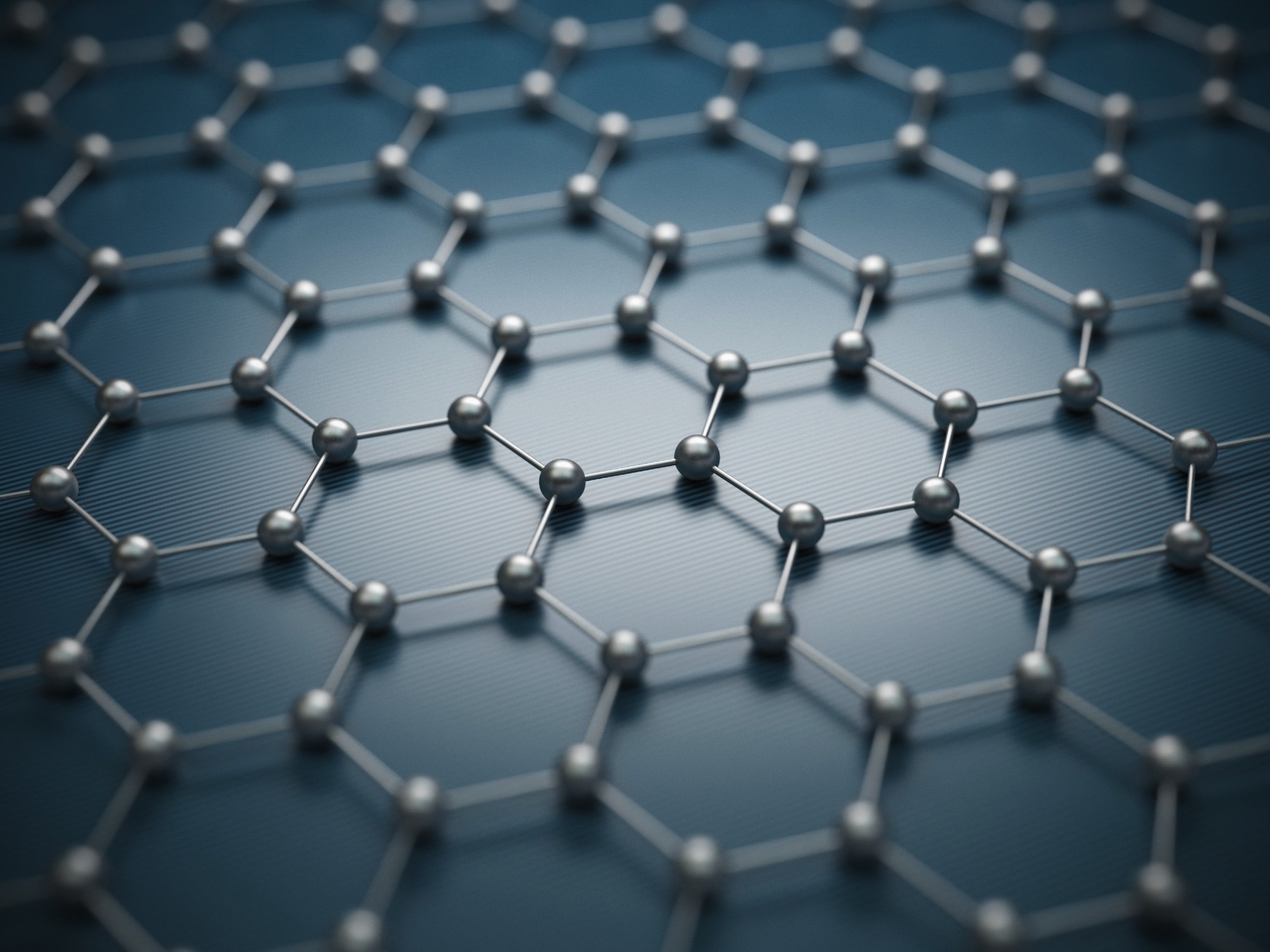In a recent Nature Communications article, researchers explored how strong electric fields influence electron behavior in graphene, uncovering nonequilibrium effects typically associated with high-energy physics.
Using advanced nano-infrared imaging techniques, the study examined how phenomena such as Cherenkov phonon emission and Schwinger-like electron-hole pair generation manifest in two-dimensional graphene systems.

Image Credit: koya979/Shutterstock.com
Background
Graphene’s exceptional electronic, optical, and mechanical properties make it a prime platform for studying quantum and classical phenomena, particularly under nonequilibrium conditions. When exposed to high electric fields, electrons in graphene accelerate to velocities where new physical regimes become accessible.
This setting draws parallels with well-known effects in high-energy physics. The Schwinger effect predicts that intense electric fields can lead to spontaneous creation of electron-hole pairs, while Cherenkov emission describes radiation released by charged particles moving faster than a medium’s phase velocity.
In graphene, these concepts emerge in the form of carrier multiplication, plasmon damping, and energy dissipation through phonon emission. Prior research has observed related effects, such as hot carrier generation and photocurrent responses, though detailed spatial mapping of these behaviors has remained challenging.
The Current Study
The experimental setup is built around an advanced nano-infrared imaging system designed to operate under cryogenic temperatures and ultra-high vacuum conditions. The primary technique combines scanning near-field optical microscopy (SNOM) with photocurrent nanoscopy, enabled by a platinum-silicide-coated atomic force microscopy (AFM) tip. This sharp tip enhances the local electromagnetic field and demodulates optical signals at the nanoscale.
A mid-infrared quantum cascade laser, tuned to a specific frequency, is used as the light source to excite plasmon polaritons within the graphene sample. To preserve high carrier mobility and minimize environmental disorder, the graphene is encapsulated between layers of hexagonal boron nitride (hBN). These encapsulated graphene ribbons, approximately 2 micrometers wide, are fabricated on either silicon or graphite substrates, which act as electrostatic gates for precise control over carrier density.
Sample preparation involves exfoliating monolayer graphene and transferring it deterministically onto hBN using a polymer-based method. The resulting heterostructure is patterned using electron beam lithography and reactive ion etching to define the ribbon geometries. Chromium and gold contacts are added to enable electrical biasing and photocurrent measurements. The completed device is housed in a cryostat maintained at roughly 30 K, which ensures thermal stability and supports ballistic electron transport—key conditions for probing delicate quantum effects.
The nano-infrared system uses a pseudo-heterodyne detection scheme, where the AFM tip acts as both a near-field probe and a demodulator for scattered light. The collected optical signals are processed by a sensitive detector, while photocurrent signals are recorded in parallel. This dual detection capability enables the generation of spatially resolved maps that reveal both the local optical response and the electronic behavior of the material.
Results and Discussion
The experiments revealed distinct asymmetries in plasmon damping when a bias current was applied to doped graphene. Plasmons propagating along the direction of electron flow experienced different damping compared to those moving against it.
This asymmetry is consistent with Cherenkov phonon emission, where electrons moving faster than acoustic phonon modes release energy via phonon emission. The result is localized heating and enhanced plasmon damping along specific directions.
High-resolution nano-infrared images showed clear interference fringes, with amplitude and damping rates strongly dependent on the direction and magnitude of the applied current. These results support the interpretation that electron drift induces directional energy dissipation through phonon emission.
Additionally, the researchers observed photocurrent enhancements and polarity reversals under strong bias conditions—features that could not be fully explained by traditional thermoelectric or bolometric models. Instead, the data suggest that tip-induced local gating modulates phonon emission, enhancing the Cherenkov effect at localized points. This effect results in photocurrent generation that reflects the underlying phonon activity, offering a new mechanism for light-to-current conversion.
Near the charge neutrality point (CNP), the team recorded sharp peaks and dips in photocurrent, unrelated to classical carrier transport. These features aligned with theoretical predictions of the Schwinger effect, where intense electric fields cause spontaneous electron-hole pair creation.
The gate- and bias-dependent nature of the signals further supports this interpretation. The coexistence of thermoelectric, bolometric, and quantum-driven processes highlights the complex interplay of mechanisms governing carrier dynamics in graphene under nonequilibrium conditions.
Download your PDF copy now!
Conclusion
This study demonstrates how strong electric fields applied to graphene can activate physical phenomena traditionally associated with high-energy physics. The direct visualization of Cherenkov-like phonon emission and Schwinger-like electron-hole pair production using nano-infrared imaging offers new insights into nonequilibrium dynamics in two-dimensional materials.
By combining spatially resolved photocurrent mapping with near-field optical imaging, the researchers have shown that graphene's response to high-field excitation involves directional energy dissipation, enhanced plasmon damping, and photocurrent generation rooted in quantum effects. These findings provide a deeper understanding of graphene's behavior under extreme conditions and expand the possibilities for exploring quantum transport and energy conversion in low-dimensional systems.
Journal Reference
Dong Y., et al. (2025). Current-driven nonequilibrium electrodynamics in graphene revealed by nano-infrared imaging. Nature Communications 16, 3861. DOI: 10.1038/s41467-025-58953-6, https://www.nature.com/articles/s41467-025-58953-6